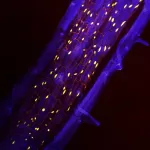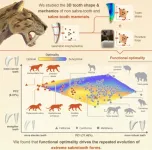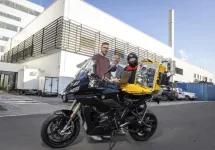(Press-News.org) LA JOLLA (January 9, 2025)—Plants may burrow into the ground and stretch toward the sun, but they’re ultimately stuck where they sprout—at the mercy of environmental threats like temperature, drought, and microbial infection. To compensate for their inability to up and move when danger strikes, many plants have evolved ways to protect themselves by altering their physiology, such as building armor around parts of their body and roots called the periderm. However, since many plant biologists who study tissue development look at young plants, later-in-life periderm development has remained relatively unexplored.
Salk Institute researchers have debuted the first comprehensive gene expression atlas of the plant periderm at the single-cell level. The atlas provides new information about the different kinds of cells that make up the periderm and which specific genes and biological processes control their development. This includes important insights into phellem cells, which are rich in suberin—a molecule that helps capture and store excess carbon from the atmosphere for a long time. Scientists can now use this information to stimulate growth of the protective periderm in plants facing environmental stress due to climate change. They can also potentially boost phellem cell growth genes to produce plants with enhanced carbon-capturing and storing abilities—a central goal of Salk’s Harnessing Plants Initiative.
The findings were published in Developmental Cell on January 9, 2025.
“Plants play a crucial role in capturing carbon from the atmosphere and storing it in the soil,” says Professor Wolfgang Busch, senior author of the study, director of the Harnessing Plants Initiative, and Hess Chair in Plant Science at Salk. “The protective outer layer of plant roots, called the periderm, is made up of many cells that can store carbon in a form that will be very durable. By creating a detailed map of how these root cells form and mature, we can better understand and potentially encourage this process to help plants hold on to more carbon in highly durable forms. In doing so, we can create more resilient plants with hardier roots that also help us fight climate change.”
When a plant first takes root, it dedicates itself to primary growth, focusing on the length of new roots. With maturity comes secondary growth, shifting the focus to thickening existing roots and creating periderm armor. This protective periderm contains phellem, phellogen, and phelloderm cells, each with distinct responsibilities and genetic profiles that had yet to be fully described in previous studies.
Of these various periderm cells, the team was most interested in phellem cells because of their high suberin content. Suberin is central to Salk’s Harnessing Plants Initiative, in which scientists optimize plants to serve as a natural and sustainable method of carbon sequestration. Unfortunately, carbon stored in leaves and stems can degrade quickly and become easily re-released into the atmosphere. In contrast, the suberin in a plant’s roots can hold carbon deep in the soil for long stretches of time. Suberin has also been shown to make plants more resistant to root rot, indicating that it serves a protective purpose in addition to carbon storage.
Previous periderm studies consisted of bulk analyses that, despite providing valuable insights, were not able to capture cell type specificity. To correct this, the Salk team applied modern single-cell sequencing techniques that could capture the distinct genetic profiles of each periderm cell type. They also tracked how gene expression changed as each cell type developed in the roots of Arabidopsis thaliana—a flowering weed in the mustard family commonly used in plant research.
"Collecting this level of detail in mature plants across time has never been achieved before,” says first author Charlotte Miller, a research scientist in Busch’s lab. “Other studies grind up entire roots and study them in bulk, but single-cell analysis allowed us to understand the genetic development of each individual cell type in the periderm. This means we can be far more precise and efficient in engineering robust, resilient, climate change-fighting plants.”
The researchers’ single-cell time-course sequencing revealed that phellem cell development can be dissected into multiple genetically distinct but interconnected phases. This stepwise development was marked by key genes like MYB67, which the team discovered was playing a large role in regulating the development process.
By piecing together the cells’ genetic profiles at different periods in their development, the team hopes to eventually determine a gene or set of genes that could be used to encourage plants to make more phellem cells, contain more suberin, and capture more durable carbon.
The periderm atlas also yielded important insights into other non-phellem cells. This data will help clarify the transitional stages in periderm development, like how phellogen cells give rise to phellem cells. Miller is particularly excited to continue studying these phellogen cells, noting that their stem-cell-like ability to differentiate into other cell types so late into the plant’s development is surprising.
As for Busch, he looks forward to seeing how suberin-containing cells plug up holes made by new lateral root growth—a destructive process where new roots break through the plants’ skin. These responsive, suberin-rich cells may not be a part of the periderm, but knowing more about the periderm cell types and suberin content may aid in future understanding of this root creation process wherein root systems branch out extensively while avoiding infection.
“Our work not only advances plant science but also opens the door to creating more robust crops and enhancing carbon sequestration through plant roots, providing solutions to both agricultural and climate challenges, which is a key goal of Salk’s Harnessing Plants Initiative,” says Busch.
Other authors include Sean Jarrell-Hurtado, Manisha Haag, Y. Sara Ye, Mathew Simenc, Paloma Alvarez-Maldonado, Sara Behnami, Ling Zhang, Joseph Swift, Ashot Papikian, Jingting Yu, Kelly Colt, Joseph Ecker, Todd Michael, and Julie Law of Salk.
The work was supported by the Bezos Earth Fund, Hess Corporation, and TED Audacious Project.
About the Salk Institute for Biological Studies:
Unlocking the secrets of life itself is the driving force behind the Salk Institute. Our team of world-class, award-winning scientists pushes the boundaries of knowledge in areas such as neuroscience, cancer research, aging, immunobiology, plant biology, computational biology, and more. Founded by Jonas Salk, developer of the first safe and effective polio vaccine, the Institute is an independent, nonprofit research organization and architectural landmark: small by choice, intimate by nature, and fearless in the face of any challenge. Learn more at www.salk.edu.
END
Two-in-one root armor protects plants from environmental stressors and fights climate change
Salk’s new single-cell analysis provides detailed first look at plant roots’ protective outer layer and carbon-capturing cells
2025-01-09
ELSE PRESS RELEASES FROM THIS DATE:
The extreme teeth of sabre-toothed predators were ‘optimal’ for biting into prey, new study reveals
2025-01-09
Sabre-toothed predators – best know from the infamous Smilodon – evolved multiple times across different mammal groups. A new study, published today in Current Biology reveals why: these teeth were ‘functionally optimal’ and highly effective at puncturing prey.
The study, led by scientists at the University of Bristol in collaboration with Monash University shows that long, sharp blade-like teeth gave sabre-tooth’s a real advantage as ...
Research spotlight: Factors contributing to treatment resistance in CAR T therapies for solid tumors
2025-01-09
Russell W. Jenkins, MD, PhD, a physician investigator in the Krantz Family Center for Cancer Research at the Mass General Cancer Center and an assistant professor of Medicine at Harvard Medical School, is senior author of a new study in Cancer Immunology Research, “TBK1 is Identified as a Therapeutic Strategy to Enhance CAR T-Cell Efficacy Using Patient-Derived Organotypic Tumor Spheroids”.
The study was a collaboration with the late Soldano Ferrone, MD, PhD, and was carried across the finish line by his daughter Cristina Ferrone, MD, Moshe Sade-Feldman, PhD, and several other collaborators ...
New findings could lead to better treatment for blood cancer
2025-01-09
Which medicine is best when you are affected by cancer? This can vary from person to person. A new method can help people with a specific type of blood cancer get the best medicine for them.
“The new method can help those affected by chronic myelogenous leukemia,” says Jennifer Sheehan, a PhD research fellow from the Department of Mechanical Engineering and Production at the Norwegian University of Science and Technology (NTNU). Sheehan was first author of a new publication in PLOS Computational Biology that describes ...
Expanded research on COPD and metabolic syndrome would advance patient-centered care
2025-01-09
Miami (January 9, 2025) – Additional research addressing the connection between chronic obstructive pulmonary disease (COPD) and metabolic syndrome is needed to improve holistic patient care, according to a new editorial. The editorial is published in the November 2024 issue of Chronic Obstructive Pulmonary Diseases: Journal of the COPD Foundation, a peer-reviewed, open-access journal.
COPD is an inflammatory lung disease, comprising several conditions, including chronic bronchitis and emphysema, and can be caused by genetics and irritants like smoke ...
Mount Sinai-led team enhances automated method to detect common sleep disorder affecting millions
2025-01-09
A Mount Sinai-led team of researchers has enhanced an artificial intelligence (AI)-powered algorithm to analyze video recordings of clinical sleep tests, ultimately improving accurate diagnosis of a common sleep disorder affecting more than 80 million people worldwide. The study findings were published in the journal Annals of Neurology on January 9.
REM sleep behavior disorder (RBD) is a sleep condition that causes abnormal movements, or the physical acting out of dreams, during the rapid eye movement (REM) phase of sleep. RBD that occurs in otherwise healthy adults ...
Dr. Ruth Westheimer, Dr. Helen Fisher, and Dr. Judith Allen donate historic archives to the Kinsey Institute
2025-01-09
The Kinsey Institute at Indiana University has acquired remarkable archives from three pioneering figures in the study of human sexuality, relationships, and wellbeing: the legendary sex therapist Dr. Ruth Westheimer, renowned anthropologist Dr. Helen Fisher, and respected feminist historian Dr. Judith Allen. These invaluable collections represent decades of groundbreaking research, education, and cultural contributions that will advance future scholarship and research.
“For almost 80 ...
Bridging oceans: A US-Japan approach to flood risk and climate resilience
2025-01-09
An innovative project jointly funded by the United States National Science Foundation (NSF) and the Japan Science and Technology Agency (JST) brings together a team of scientists from Florida Atlantic University and Lehigh University, along with a team from Japan that includes researchers from Kyoto University, University of Tokyo and Kumamoto University.
The project, titled “NSF-JST: An Inclusive Human-Centered Risk Management Modeling Framework for Flood Resilience,” is supported by a three-year, $1 million award split evenly between the U.S. and Japanese teams, with the U.S. team receiving $499,271. ...
Dense human population is linked to longer urban coyote survival
2025-01-09
COLUMBUS, Ohio – Tracking coyote movement in metropolitan areas shows the animals spend lots of time in natural settings, but a new study suggests the human element of city life has a bigger impact than the environment on urban coyote survival.
Researchers monitoring coyotes in Chicago found that habitat – areas with relatively high levels of vegetation cover and low levels of human infrastructure – did not influence coyote survival in positive or negative ways. Instead, areas densely populated with humans were ...
Science educator calls for climate change to be taught more in US schools
2025-01-09
Given that today’s children will inherit the consequences of climate change, schools are instrumental in mobilizing a global response to the climate crisis, a science educator argues.
Climate literacy advocate Kelley T. Lê argues that climate change is the defining issue of our time, and in her new book, Teaching Climate Change for Grades 6–12: Activating Science Teachers to Take on the Climate Crisis Through NGSS, Lê provides teachers, administrators, and global leaders with practical tools to empower ...
Realistic emission tests for motorbikes, mopeds and quads
2025-01-09
The emissions scandal in the automotive industry that came to light in 2015 has set many things in motion. Last but not least, the discussion about the need for realistic tests for vehicles in order to correctly determine their pollutant emissions instead of just testing on test rigs. Such tests and the applicable emission limits are now required by law for cars, but not for so-called category-L vehicles (mopeds, motorbikes, tricycles and quads). As part of the “LENS” project (L-vehicles Emissions and Noise mitigation Solutions) funded by the European ...
LAST 30 PRESS RELEASES:
Scientists to ‘spy’ on cancer- immune cell interactions using quantum technology breakthrough
Tech savvy users have most digital concerns
Making lighter work of calculating fluid and heat flow
Normalizing blood sugar can halve heart attack risk
Lowering blood sugar cuts heart attack risk in people with prediabetes
Study links genetic variants to risk of blinding eye disease in premature infants
Non-opioid ‘pain sponge’ therapy halts cartilage degeneration and relieves chronic pain
AI can pick up cultural values by mimicking how kids learn
China’s ecological redlines offer fast track to 30 x 30 global conservation goal
Invisible indoor threats: emerging household contaminants and their growing risks to human health
Adding antibody treatment to chemo boosts outcomes for children with rare cancer
Germline pathogenic variants among women without a history of breast cancer
Tanning beds triple melanoma risk, potentially causing broad DNA damage
Unique bond identified as key to viral infection speed
Indoor tanning makes youthful skin much older on a genetic level
Mouse model sheds new light on the causes and potential solutions to human GI problems linked to muscular dystrophy
The Journal of Nuclear Medicine ahead-of-print tip sheet: December 12, 2025
Smarter tools for peering into the microscopic world
Applications open for funding to conduct research in the Kinsey Institute archives
Global measure underestimates the severity of food insecurity
Child survivors of critical illness are missing out on timely follow up care
Risk-based vs annual breast cancer screening / the WISDOM randomized clinical trial
University of Toronto launches Electric Vehicle Innovation Ontario to accelerate advanced EV technologies and build Canada’s innovation advantage
Early relapse predicts poor outcomes in aggressive blood cancer
American College of Lifestyle Medicine applauds two CMS models aligned with lifestyle medicine practice and reimbursement
Clinical trial finds cannabis use not a barrier to quitting nicotine vaping
Supplemental nutrition assistance program policies and food insecurity
Switching immune cells to “night mode” could limit damage after a heart attack, study suggests
URI-based Global RIghts Project report spotlights continued troubling trends in worldwide inhumane treatment
Neutrophils are less aggressive at night, explaining why nighttime heart attacks cause less damage than daytime events
[Press-News.org] Two-in-one root armor protects plants from environmental stressors and fights climate changeSalk’s new single-cell analysis provides detailed first look at plant roots’ protective outer layer and carbon-capturing cells





